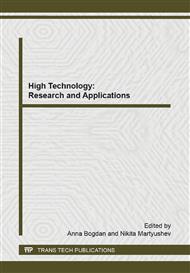[1]
H. Zollinger, Diazo Chemistry I: Aromatic and Heteroaromatic Compounds; VCH: Weinheim, (1994).
Google Scholar
[2]
R. Pazo-Llorente, H. Maskill, C. Bravo-Diaz and E. Gonzalez-Romero, Dediazoniation of 4-nitrobenzenediazonium ions in acidic MeOH/H2O mixtures: role of acidity and MeOH concentration on the formation of transient diazo ethers that initiate homolytic dediazoniation, Eur. J. Org. Chem. 9 (2006).
DOI: 10.1002/ejoc.200500946
Google Scholar
[3]
R. Pazo-Llorente, C. Bravo-Diaz and E. Gonzalez-Romero, pH effects on ethanolysis of some arenediazonium ions: evidence for homolytic dediazoniation proceeding through formation of transient diazo ethers, Eur. J. Org. Chem. 15 (2004) 3221–3226.
DOI: 10.1002/ejoc.200400170
Google Scholar
[4]
W F.W. assmundt, W.F. Kiesman, Detection of aryl radicals in hydrodediazoniations, J. Org. Chem. 62 (1997) 8304 – 8308.
DOI: 10.1021/jo962128y
Google Scholar
[5]
C. Bravo-Díaz , M E. Romero-Nieto, and E. Gonzalez-Romero, Micellar-promoted homolytic dediazoniation of p-nitrobenzenediazonium Tetrafluoroborate, Langmuir 16 (2000) 42-48.
DOI: 10.1021/la9901682
Google Scholar
[6]
U. Costas-Costas, C. Bravo-Diaz, E. Gonzalez-Romero, Kinetics and mechanism of the reaction between ascorbic acid derivatives and an arenediazonium salt: cationic micellar effects, Langmuir 21 (2005) 10983–10991.
DOI: 10.1021/la051564p
Google Scholar
[7]
C. Bravo-Diaz, E. Gonzalez-Romero, Inhibition of the β-cyclodextrin catalyzed dediazoniation of 4-nitrobenzenediazonium tetrafluoroborate. Blocking effect of sodium dodecyl sulfate, Langmuir 21 (2005) 4888–4895.
DOI: 10.1021/la050111h
Google Scholar
[8]
K. Daasbjerg, K. Sehested, Reduction of substituted benzenediazonium salts by hydrogen atoms in aqueous acidic solution studied by pulse radiolysis, J. Phys. Chem. A 107 (2003) 4462-4469.
DOI: 10.1021/jp0273732
Google Scholar
[9]
V.D. Filimonov, P.S. Postnikov, E.A. Krasnokutskaya, Y.M. Lee, H.Y. Hwang, H. Kim and Ki-Whan Chi, Unusually stable, versatile, and pure arenediazonium tosylates: their preparation, structures, and synthetic applicability, Org. Lett. 10 (2008).
DOI: 10.1021/ol8013528
Google Scholar
[10]
A.E. Ermakov, M.A. Uimin, E.S. Lokteva, A.A. Mysik, S.A. Kachevskii, A.O. Turakulova, V.S. Gaviko, and V.V. Lunin, The synthesis, structure, and properties of carbon-containing nanocomposites based on nickel, palladium, and iron, Russ. J. Phys. Chem. 83 (2009).
DOI: 10.1134/s0036024409070243
Google Scholar
[11]
E.S. Lokteva, S.A. Kachevskii, A. O. Turakulova, E. V. Golubina, V.V. Lunin, A.E. Ermakov, M.A. Uimin, and A.A. Mysik, The hydrodechlorination of chlorobenzene in the vapor phase in the presence of metal–carbon nanocomposites based on nickel, palladium, and iron, Russ. J. Phys. Chem. A 83 (2009).
DOI: 10.1134/s003602440908010x
Google Scholar
[12]
A.V. Mekhaev, O.N. Chupakhin, M.A. Uimin, Liquid-phase catalytic hydrodechlorination of aromatic chloro derivatives with metal nanopowders, Rus. Chem. Bull. 58 (2009) 1321- -1324.
DOI: 10.1007/s11172-009-0175-3
Google Scholar
[13]
P.S. Postnikov, M.E. Trusova, T.A. Fedushchak, M.A. Uimin, A.E. Ermakov, V.D. Filimonov, Aryldiazonium tosylates as new efficient agents for covalent grafting of aromatic groups on carbon coatings of metal nanoparticles, Nanotechnologies in Russia 5 (2010).
DOI: 10.1134/s1995078010070037
Google Scholar


